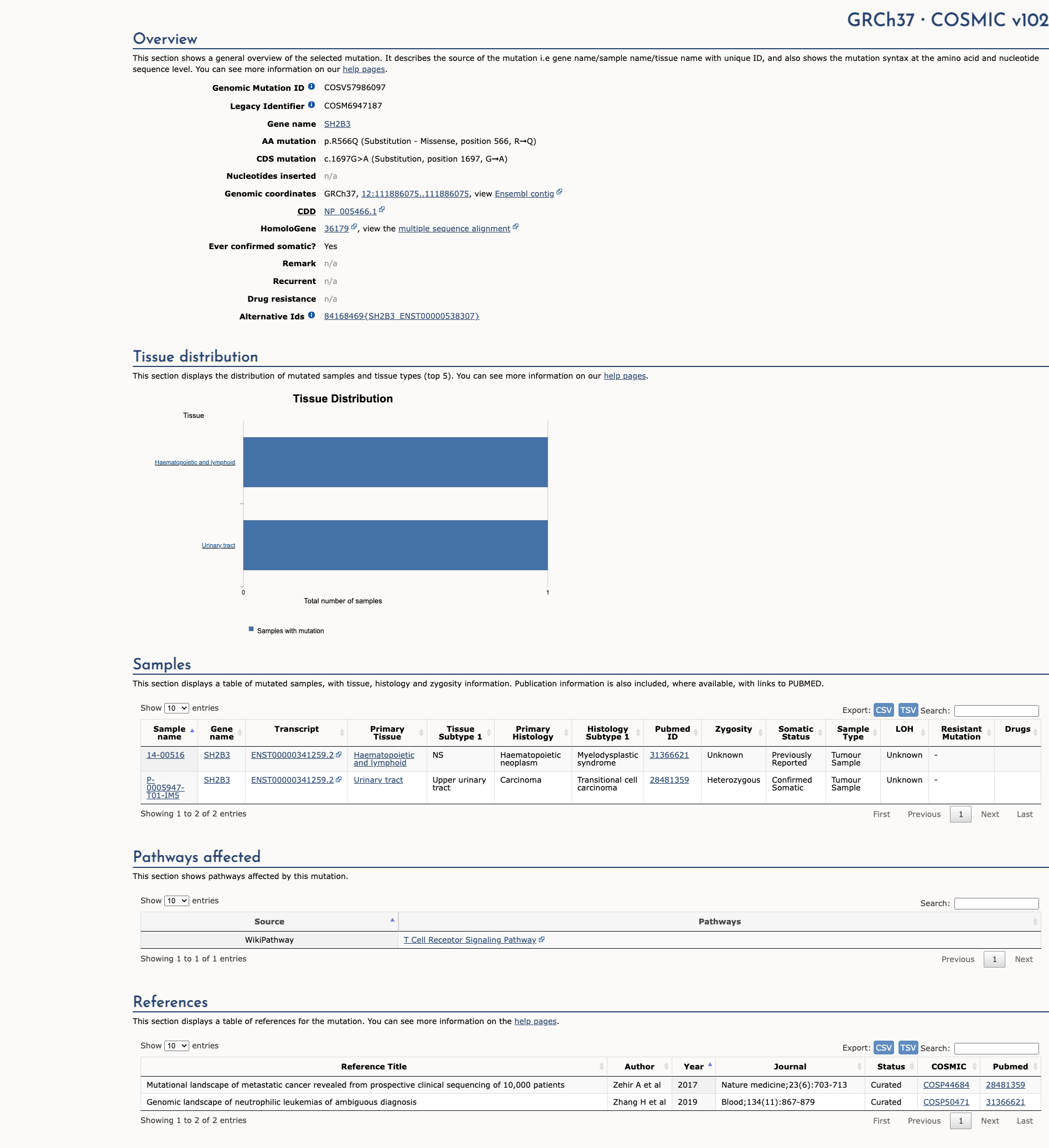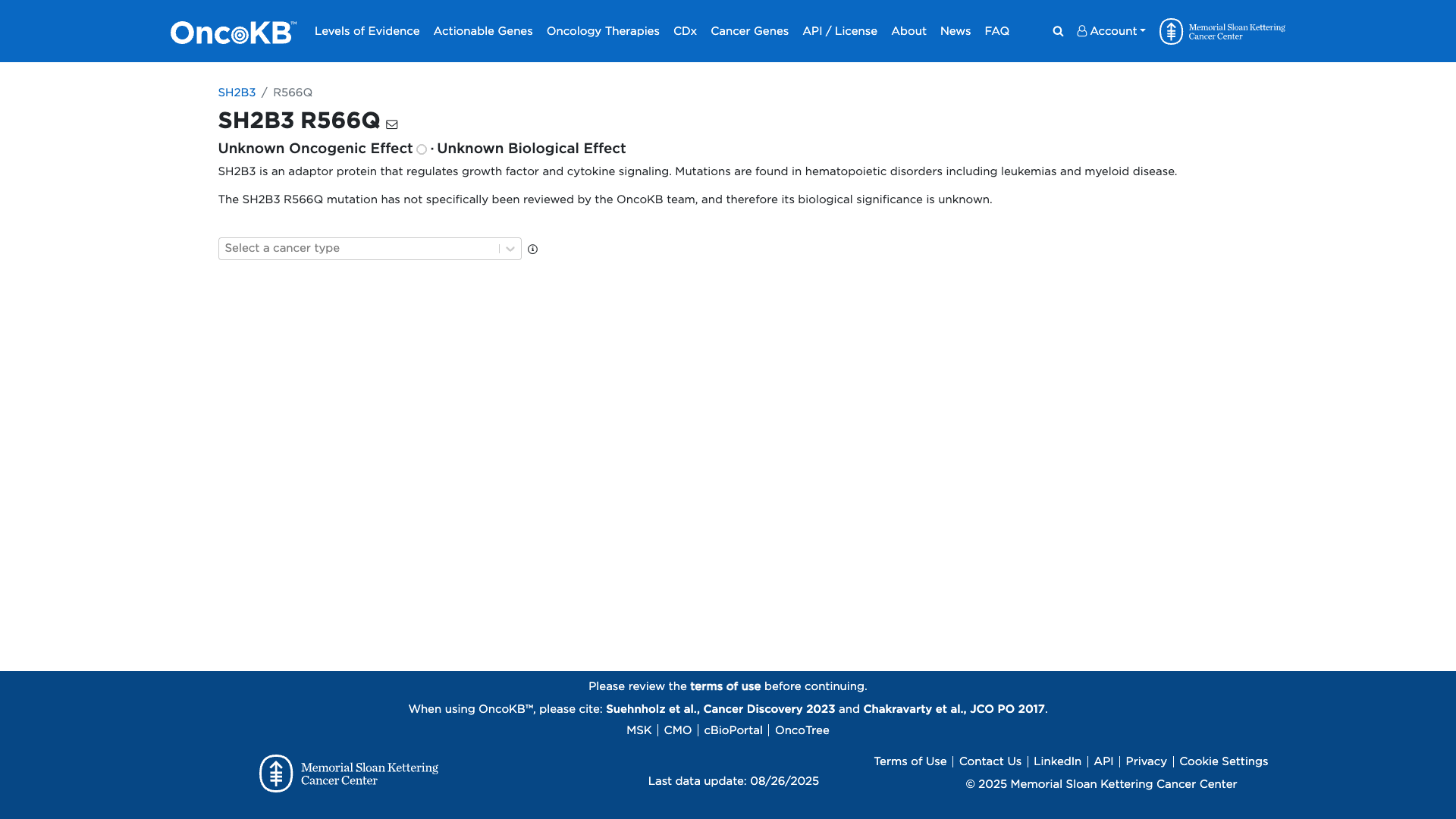SH2B3 c.1697G>A, p.Arg566Gln
NM_005475.2:c.1697G>A
COSMIC ID: COSM6947187
Variant of Uncertain Significance (VUS)
This SH2B3 R566Q variant meets one Moderate criterion (PM2) for rarity and one Supporting criterion (BP4) from computational data, with no additional evidence to fulfill other pathogenic or benign criteria. Therefore, it remains classified as a Variant of Uncertain Significance.
ACMG/AMP Criteria Applied
PM2
BP4
Genetic Information
Gene & Transcript Details
Gene
SH2B3
Transcript
NM_005475.3
MANE Select
Total Exons
8
Strand
Forward (+)
Reference Sequence
NC_000012.11
Alternative Transcripts
| ID | Status | Details |
|---|---|---|
| NM_005475.1 | Alternative | 8 exons | Forward |
| NM_005475.2 | RefSeq Select | 8 exons | Forward |
Variant Details
HGVS Notation
NM_005475.2:c.1697G>A
Protein Change
R566Q
Location
Exon 8
(Exon 8 of 8)
5'Exon Structure (8 total)3'
Functional Consequence
Loss of Function
Related Variants
No evidence of other pathogenic variants at position 566 in gene SH2B3
Alternate Identifiers
COSM6947187
Variant interpretation based on transcript NM_005475.3
Genome Browser
Loading genome browser...
HGVS InputNM_005475:c.1697G>A
Active Tracks
ConservationRefSeqClinVargnomAD
Navigation tips: Use mouse to drag and zoom. Click on features for details.
Clinical Data
Global Frequency
0.00816%
Rare
Highest in Population
European (non-Finnish)
0.014%
Low Frequency
Global: 0.00816%
European (non-Finnish): 0.014%
0%
0.05%
0.1%
1%
5%
10%+
Allele Information
Total: 281966Alt: 23Homozygotes: 0
ACMG Criteria Applied
PM2
This variant is present in gnomAD (MAF= 0.00816%, 23/281966 alleles, homozygotes = 0) and at a higher frequency in the European (non-Finnish) population (MAF= 0.014%, 18/128696 alleles, homozygotes = 0). The variant is rare (MAF < 0.1%), supporting PM2 criterion application.
Classification
Unknown
Publications (0)
No publication details.
Clinical Statement
Functional Impact
Functional Domain
Hotspot Status
Not a hotspot
Domain Summary
This variant is not located in a mutational hotspot or critical domain (0 mutations).
Related Variants in This Domain
No evidence of other pathogenic variants at position 566 in gene SH2B3
Computational Analysis
Pathogenicity Predictions
REVEL Score
0.474
0.474
Likely Benign0.0
Uncertain (Low)0.2
Uncertain (Med)0.5
Likely Pathogenic0.75
REVEL scores ≥ 0.75 are strong evidence (PP3)
Predictor Consensus
Mixed/VUS
PP3 Applied
No
Additional Predictors
Pathogenic:
polyphen_prediction: probably_damaging
Benign:
CADD: 6.05metasvm: Tmetalr: Tprimateai: T
Neutral: Show all
VCEP Guidelines
Applied ACMG/AMP Criteria (VCEP Specific)
PVS1
PVS1 (Not Applied) Strength Modified
According to standard ACMG guidelines, the rule for PVS1 is: "Null variant in a gene where LoF is a known mechanism of disease." The evidence for this variant shows it is a missense change (R566Q), not a null variant. Therefore, this criterion is not applied because the variant does not result in loss of function.
PS1
PS1 (Not Applied) Strength Modified
According to standard ACMG guidelines, the rule for PS1 is: "Same amino acid change as a known pathogenic variant but different nucleotide change." The evidence for this variant shows no previously established pathogenic variant at residue R566. Therefore, this criterion is not applied because no identical amino acid change has been reported as pathogenic.
PS2
PS2 (Not Applied) Strength Modified
According to standard ACMG guidelines, the rule for PS2 is: "De novo (both maternity and paternity confirmed) in a patient with the disease and no family history." The evidence for this variant shows no de novo data are available. Therefore, this criterion is not applied due to lack of de novo confirmation.
PS3
PS3 (Not Applied) Strength Modified
According to standard ACMG guidelines, the rule for PS3 is: "Well-established functional studies supportive of a damaging effect on the gene or gene product." The evidence for this variant shows no functional studies have been performed. Therefore, this criterion is not applied due to absence of functional data.
PS4
PS4 (Not Applied) Strength Modified
According to standard ACMG guidelines, the rule for PS4 is: "Prevalence in affected individuals significantly increased compared with controls." The evidence for this variant shows no case-control data. Therefore, this criterion is not applied due to lack of prevalence data.
PM1
PM1 (Not Applied) Strength Modified
According to standard ACMG guidelines, the rule for PM1 is: "Located in a mutational hot spot or well-established functional domain without benign variation." The evidence for this variant shows no annotation of a mutational hotspot or critical domain at R566. Therefore, this criterion is not applied.
PM2
PM2 (Moderate)
According to standard ACMG guidelines, the rule for PM2 is: "Absent from controls (or at extremely low frequency if recessive)." The evidence for this variant shows a MAF of 0.00816% in gnomAD with no homozygotes. Therefore, this criterion is applied at Moderate strength because the variant is extremely rare in population databases.
PM3
PM3 (Not Applied) Strength Modified
According to standard ACMG guidelines, the rule for PM3 is: "Detected in trans with a pathogenic variant (for recessive disorders)." The evidence for this variant shows no data on phase or trans configuration. Therefore, this criterion is not applied.
PM4
PM4 (Not Applied) Strength Modified
According to standard ACMG guidelines, the rule for PM4 is: "Protein length changes due to in-frame deletions/insertions or stop-loss variants." The evidence for this variant shows it is a missense change without protein length alteration. Therefore, this criterion is not applied.
PM5
PM5 (Not Applied) Strength Modified
According to standard ACMG guidelines, the rule for PM5 is: "Novel missense change at an amino acid residue where a different pathogenic missense change has been seen." The evidence for this variant shows no other pathogenic missense variants at residue R566. Therefore, this criterion is not applied.
PM6
PM6 (Not Applied) Strength Modified
According to standard ACMG guidelines, the rule for PM6 is: "Assumed de novo, but without confirmation of paternity and maternity." The evidence for this variant shows no parental testing data. Therefore, this criterion is not applied.
PP1
PP1 (Not Applied) Strength Modified
According to standard ACMG guidelines, the rule for PP1 is: "Co-segregation with disease in multiple affected family members." The evidence for this variant shows no segregation data. Therefore, this criterion is not applied.
PP2
PP2 (Not Applied) Strength Modified
According to standard ACMG guidelines, the rule for PP2 is: "Missense variant in a gene with a low rate of benign missense variation and where missense variants are a common mechanism of disease." The evidence for this variant shows no data on gene-specific missense constraint. Therefore, this criterion is not applied.
PP3
PP3 (Not Applied) Strength Modified
According to standard ACMG guidelines, the rule for PP3 is: "Multiple lines of computational evidence support a deleterious effect." The evidence for this variant shows mixed in silico predictions and SpliceAI score of 0.02, not consistently deleterious. Therefore, this criterion is not applied.
PP4
PP4 (Not Applied) Strength Modified
According to standard ACMG guidelines, the rule for PP4 is: "Patient's phenotype or family history highly specific for a disease with a single genetic etiology." The evidence for this variant shows no phenotype data provided. Therefore, this criterion is not applied.
PP5
PP5 (Not Applied) Strength Modified
According to standard ACMG guidelines, the rule for PP5 is: "Reputable source reports variant as pathogenic, but without accessible evidence." The evidence for this variant shows it is not reported in ClinVar or other reputable sources. Therefore, this criterion is not applied.
BA1
BA1 (Not Applied) Strength Modified
According to standard ACMG guidelines, the rule for BA1 is: "Allele frequency is too high for the disorder (stand-alone evidence)." The evidence for this variant shows a frequency of 0.00816%, well below the BA1 threshold. Therefore, this criterion is not applied.
BS1
BS1 (Not Applied) Strength Modified
According to standard ACMG guidelines, the rule for BS1 is: "Allele frequency is greater than expected for disorder." The evidence for this variant shows a very low frequency that does not exceed expected disorder prevalence thresholds. Therefore, this criterion is not applied.
BS2
BS2 (Not Applied) Strength Modified
According to standard ACMG guidelines, the rule for BS2 is: "Observed in a healthy adult individual for a dominant disorder with full penetrance expected at an early age." The evidence for this variant shows no data on healthy adult observations. Therefore, this criterion is not applied.
BS3
BS3 (Not Applied) Strength Modified
According to standard ACMG guidelines, the rule for BS3 is: "Well-established functional studies show no damaging effect on protein function or splicing." The evidence for this variant shows no functional studies performed. Therefore, this criterion is not applied.
BS4
BS4 (Not Applied) Strength Modified
According to standard ACMG guidelines, the rule for BS4 is: "Lack of segregation in affected family members." The evidence for this variant shows no segregation data. Therefore, this criterion is not applied.
BP1
BP1 (Not Applied) Strength Modified
According to standard ACMG guidelines, the rule for BP1 is: "Missense variant in a gene where only loss of function causes disease." The evidence for this variant shows no established mechanism restricting pathogenicity to loss of function only. Therefore, this criterion is not applied.
BP2
BP2 (Not Applied) Strength Modified
According to standard ACMG guidelines, the rule for BP2 is: "Observed in trans with a pathogenic variant for dominant disorders or in cis with a pathogenic variant." The evidence for this variant shows no information on cis/trans status with other variants. Therefore, this criterion is not applied.
BP3
BP3 (Not Applied) Strength Modified
According to standard ACMG guidelines, the rule for BP3 is: "In-frame deletions/insertions in a repetitive region without known function." The evidence for this variant shows it is a missense substitution, not an in-frame indel. Therefore, this criterion is not applied.
BP4
BP4 (Supporting)
According to standard ACMG guidelines, the rule for BP4 is: "Multiple lines of computational evidence suggest no impact on gene or gene product." The evidence for this variant shows mixed predictions, REVEL score 0.47 below pathogenic threshold, and SpliceAI score 0.02 indicating no splicing impact. Therefore, this criterion is applied at Supporting strength because in silico data largely suggest benign impact.
BP5
BP5 (Not Applied) Strength Modified
According to standard ACMG guidelines, the rule for BP5 is: "Variant found in a case with an alternate molecular basis for disease." The evidence for this variant shows no such cases reported. Therefore, this criterion is not applied.
BP6
BP6 (Not Applied) Strength Modified
According to standard ACMG guidelines, the rule for BP6 is: "Reputable source reports variant as benign, but without accessible evidence." The evidence for this variant shows no entries in ClinVar or similar databases. Therefore, this criterion is not applied.
BP7
BP7 (Not Applied) Strength Modified
According to standard ACMG guidelines, the rule for BP7 is: "Synonymous variant with no predicted impact on splicing." The evidence for this variant shows it is a missense change, not synonymous. Therefore, this criterion is not applied.



